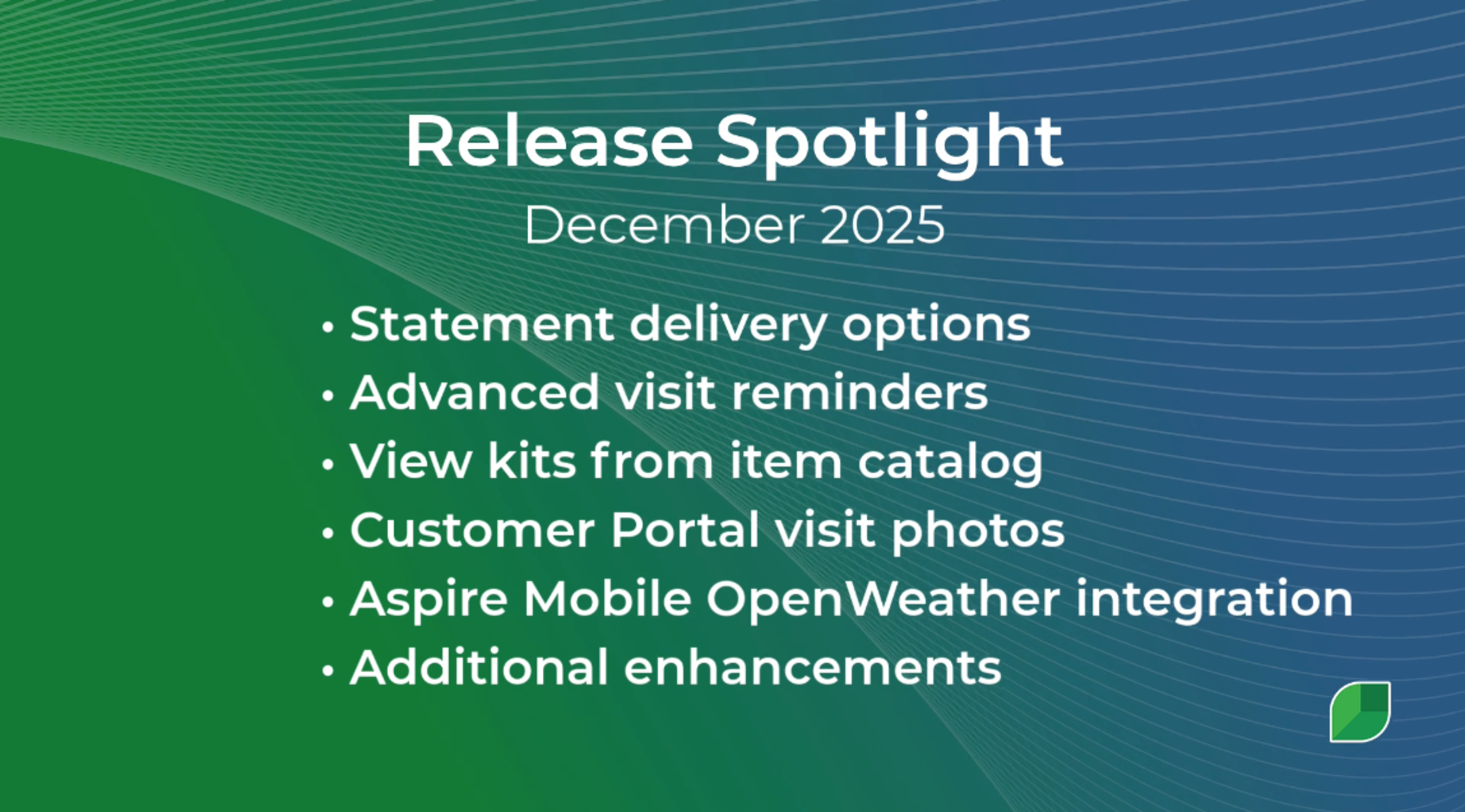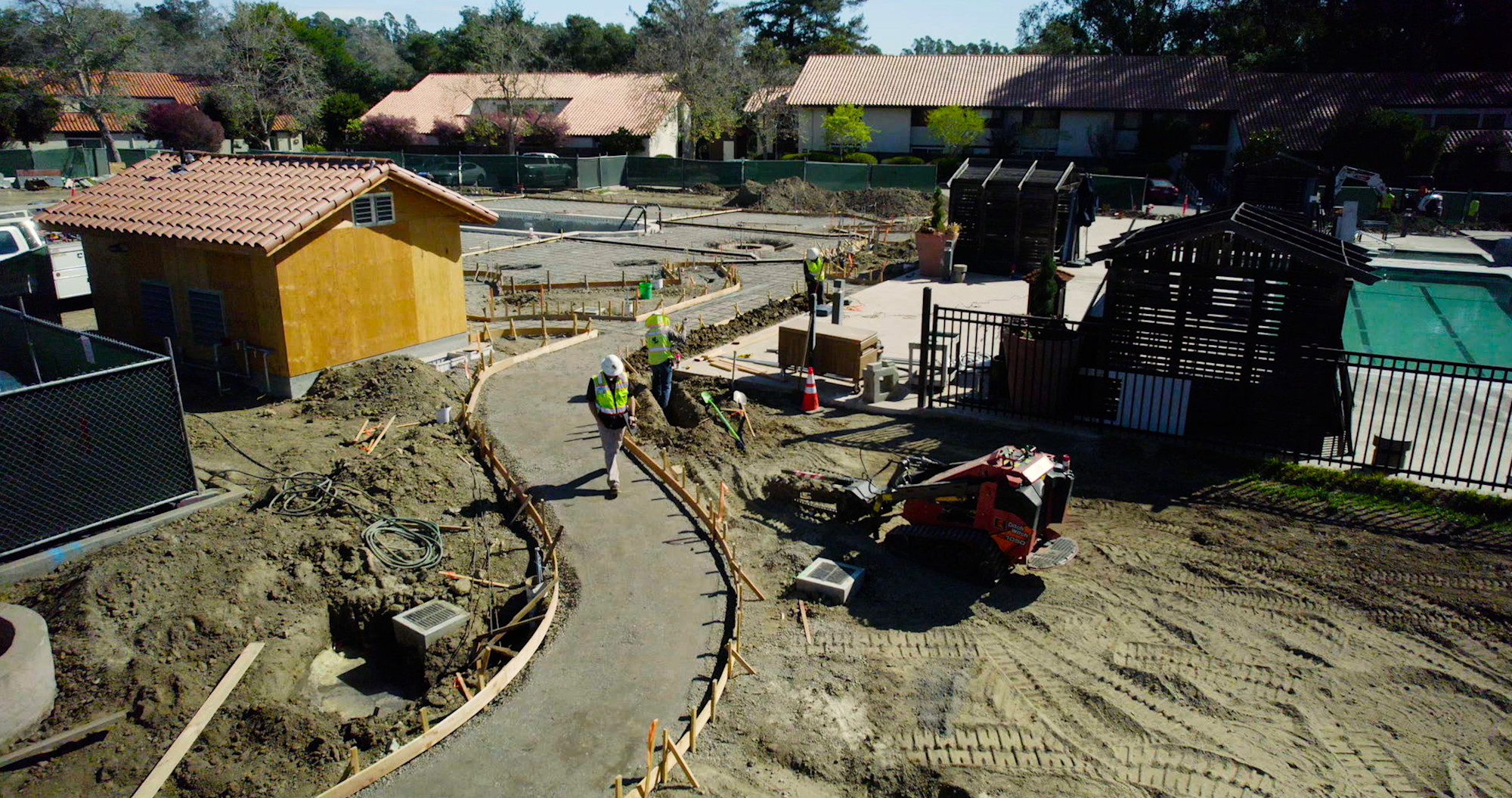Table of Contents
Table of Contents
- What’s driving the landscaping labor shortage in 2025?
- Seasonal surges and unpredictable demand
- Immigration restrictions and fewer H-2B visas are shrinking the workforce
- Physical demands create recruitment barriers
- Booming demand is outpacing the workforce
- How can you attract more reliable landscaping talent?
- 1. Offer competitive wages
- 2. Provide clear career opportunities within your company
- 3. Create an employee referral program
- 4. Build partnerships with local schools and community programs
- 5. Market your company culture and values to job seekers
- What are the best ways to retain existing talent?
- 1. Give regular, meaningful feedback to show employees they matter
- 2. Balance workloads to prevent burnout and resentment
- 3. Offer training to support long-term growth
- How to improve labor efficiency with the team you have
- Streamline crew scheduling and assignments
- Track time, productivity, and job costs accurately
- Invest in equipment that reduces labor dependence
- Can you outsource or subcontract when staffing falls short?
- Recognize when you need external help
- Vet subcontractors like you would full-time hires
- Define clear scopes, expectations, and standards
- Keep outsourced crews aligned with your schedule
- Track performance and make data-driven outsourcing decisions
- Over to you!
Do you know that the US landscaping industry is worth over $178 billion and employs more than a million workers?
However, as the green industry expands and demand for its services increases, it faces a looming challenge: labor shortages.
In fact, 51% of landscapers in a survey of over 1,000 industry professionals consider labor shortages one of their greatest risks.
So, how can you solve this issue and avoid being overwhelmed by unfilled shifts?
In this guide, you’ll learn:
How thriving landscapers attract reliable employees
Best ways to retain your workers
How to improve labor efficiency with the current workforce
When to outsource or subcontract projects
The proven strategies provided here will help you navigate the labor shortage challenge and keep your business thriving.
What’s driving the landscaping labor shortage in 2025?
When industries like technology and IT experience growth, they attract a wave of talent, especially young people seeking stability and high pay.
However, in fields like landscaping and construction, the opposite is happening. Despite rising demand for landscape services, the available workforce can’t meet the demand.
But what’s triggering the labor shortage in landscaping, and why is it a major issue in 2025? Keep reading to find out.
Seasonal surges and unpredictable demand
First, you need to understand that the US employment rate is generally low, 4.2%, according to the Bureau of Labor Statistics.
However, the seasonal fluctuations of landscaping services make staffing and scheduling even more unpredictable.
There's intense but short-term worker demand during peak seasons (summer and spring). In the winter, there’s less demand, making it difficult to maintain a stable workforce year-round.
This weather-dependent working condition means schedules can shift quickly, making jobs less predictable and harder to commit to.
Workers, on the other hand, need stability and full-time roles, which some landscaping businesses can’t guarantee.
This volatility makes it challenging to recruit and retain dependable landscaping staff.
Immigration restrictions and fewer H-2B visas are shrinking the workforce
Many landscaping businesses rely on foreign workers through the H-2B visa program. This system typically allows landscaping businesses to hire workers during peak seasons.
However, stricter immigration policies and visa caps have limited this labor source. Right now, the visa cap is 66,000 per year, and it’s often exhausted quickly, leaving landscaping companies without workers during peak seasons.
Physical demands create recruitment barriers
Employees typically work under harsh weather conditions, operate heavy equipment, and have a basic understanding of soil chemistry or irrigation systems.
It’s physically demanding work that requires a level of expertise.
Yet, the pay doesn’t always match the demands. When workers can earn comparable pay in better conditions and with less physical strain, the choice is clear. With such a pay gap, it’s tough to attract skilled landscapers who know their worth.
Booming demand is outpacing the workforce
With residential and commercial property numbers soaring and new construction everywhere, homeowners and businesses are investing heavily in their outdoor spaces.
They want a good-looking lawn and stunning landscape design. But while there’s been an increased demand for landscaping services, the number of available workers remains flat or has declined in some areas.
The result is more projects than there are professionals to complete them, further aggravating the existing limited workforce situation.
Despite these shortcomings, however, there are landscaping companies that are thriving talent-wise. Learn how you can do the same below.
How can you attract more reliable landscaping talent?
Sure, finding trustworthy landscapers is challenging at the moment, but it’s not impossible. Here’s how to attract dependable crew members with industry-leading talent for your landscaping business:
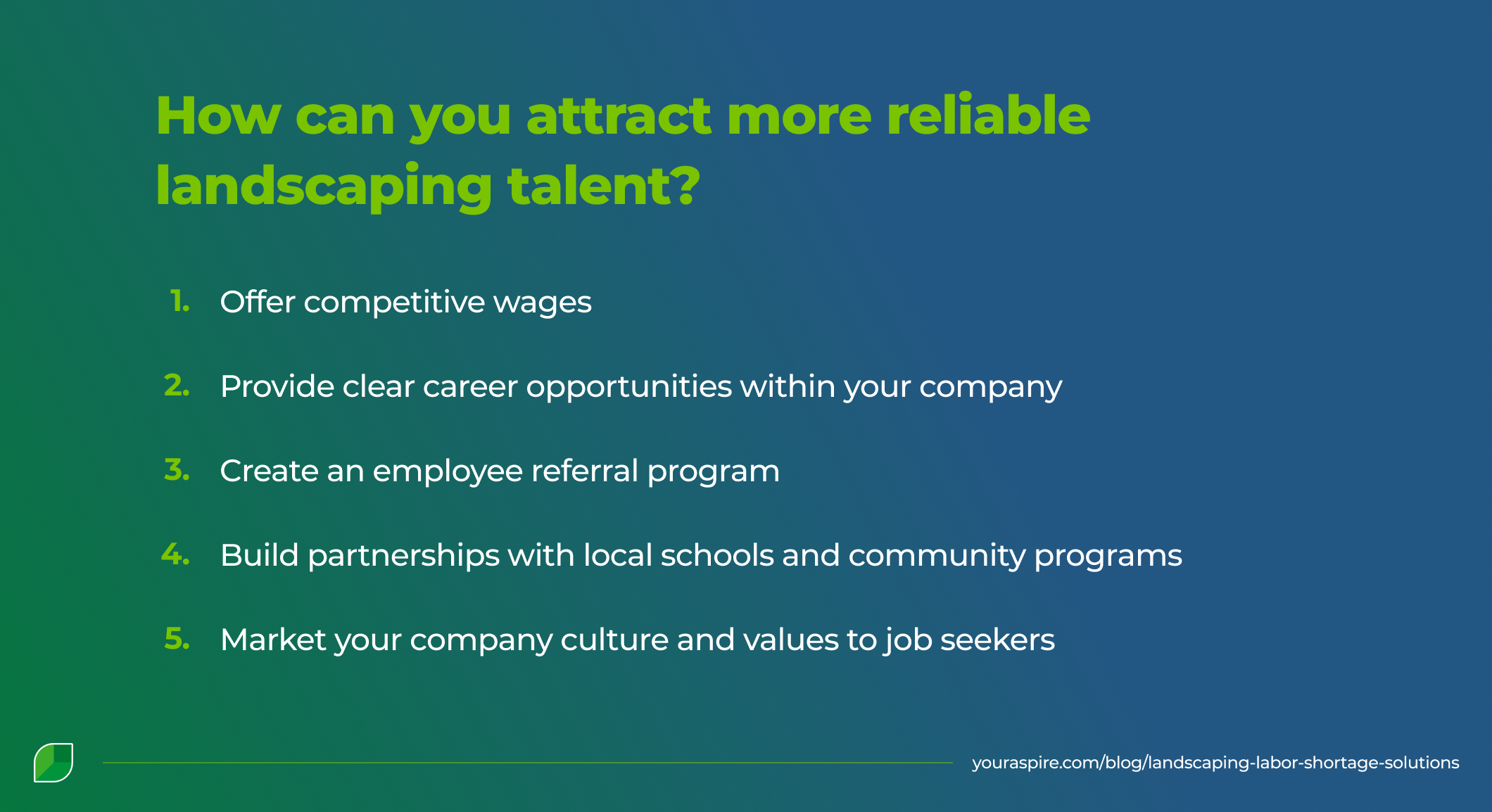
1. Offer competitive wages
Landscaping wages are falling behind, and workers are noticing. For example, here are the average annual salaries for:
Warehouse workers: $43,659
Delivery drivers: $72,102
Plumbers: $101,804
In comparison, here’s what landscaping professionals are paid:
Landscape laborers: $42,945
Landscape foreman: $70,028
Landscape technicians: $71,757
If your pay is at the lower end of the scale, attracting and retaining quality talent will be a challenge compared to other industries. And that needs to change.
Don’t know how much to pay? Read this guide on paying landscaping employees. But it’s not just about wages.
Young and energetic workers are motivated by a healthy work culture that recognizes their efforts with incentives.
To make your offer more appealing, consider offering other perks like attendance bonuses, paid time off, health insurance, or gas stipends.
Leverage digital tools like Aspire to track work hours and job performance to give workers performance-based incentives.
Always remember that when it comes to labor shortage, you’re not just competing with other landscapers but with other industries too.
2. Provide clear career opportunities within your company
Sometimes, landscaping companies find it hard to retain talent because they don’t have clear career paths for their employees.
Say they came in as laborers. Are there career ladders that show workers the opportunities and criteria required to move up in the company? Such structures can help you retain loyal crew members by showing them how they fit into your company.
Here’s how you can implement a ladder system:
Define roles and responsibilities for each level: Draw out career paths like a flow chart to illustrate employee opportunities, e.g., laborer → crew lead → supervisor → technician. Spell out the duties of each role and the skills, training, or certifications needed. If there’s a cost to training or certifications, be clear about what the company will cover and the expectations for the employees.
Outline wages for each role: What’s the base and highest salary a role can reach? In other words, what’s the maximum pay a laborer can earn? Once they hit the threshold, clarify what’s needed to earn their next raise. This could be learning new skills or getting certifications.
Create a bonus structure that aligns with your business goals: This simply means incentivizing employees when they achieve one or more of your company's goals. Did they exceed sales or production targets? Finished a project long before the estimated hours? Reward them for it.
This system helps attract and retain workers eager to take ownership of their roles and tasks in the company. It makes them feel like this is their business, so they are more inclined to remain loyal.
3. Create an employee referral program
This program can help you find new staff who understand the company’s culture and are professionals your existing employees want to work with.
It involves asking current workers to refer people in their network for a landscaping job opportunity. The trick to maximizing this referral program isn’t just asking them to share the word, but providing an incentive to motivate them.
Here’s how Emerald Lawn Care, Inc., based in Rolling Meadows, Illinois, structures its employee referral program:
Set reward amount: Employees can earn up to $1,000 in referral bonuses.
Define success criteria: Workers receive $250 on the first day the new hire begins, $500 after they stay for six months, and $250 if they stay for a whole year.
4. Build partnerships with local schools and community programs
Visit institutions—vocational schools or community colleges—where landscaping-related courses are offered, either to organize job fairs or directly present career opportunities to the students.
You could also hire young interns or apprentices from these facilities who can learn the ropes to become landscapers. Clearly explain the career ladder path they’ll take by becoming an intern or apprentice.
This initiative can help you stand out when searching for workers, as most landscaping companies search for ready-made professionals. However, keep in mind that this might be a long-term solution to having a reliable crew.
5. Market your company culture and values to job seekers
Another way you can attract top young talent is to position your landscaping company as:
A thriving environment.
A leader in modern tech and practices, offering clear career growth paths.
An institution with continuous learning opportunities.
A brand with a strong commitment to sustainability and innovation.
Essentially, let it show potential workers that they can find purpose, flexibility, a supportive environment, and upskilling opportunities at your company. It’s a big deal for employees now.
In fact, a global workforce report by PWC indicates that upskilling opportunities are a critical factor for employees seeking to switch employers.
Here are some ideas to help market your company’s value and offering to job seekers or prospects:
Share employee stories on social media and the business’s website.
Create behind-the-scenes content for social media.
Highlight upskilling opportunities the company provides on the website and job application page.
Ensure your content strategy reflects the company culture. Let prospects understand what it’s like to work for you as they consume your digital content.
What are the best ways to retain existing talent?
Employees are like customers in a way; building a reliable workforce takes clear communication and relationship-building.
However, many businesses focus only on the onboarding process and wages, forgetting that their workers have needs and are the driving force of the operation.
Provide working conditions and experience that competitors can’t beat to retrain your landscaping crew. Here are three ways to do that:
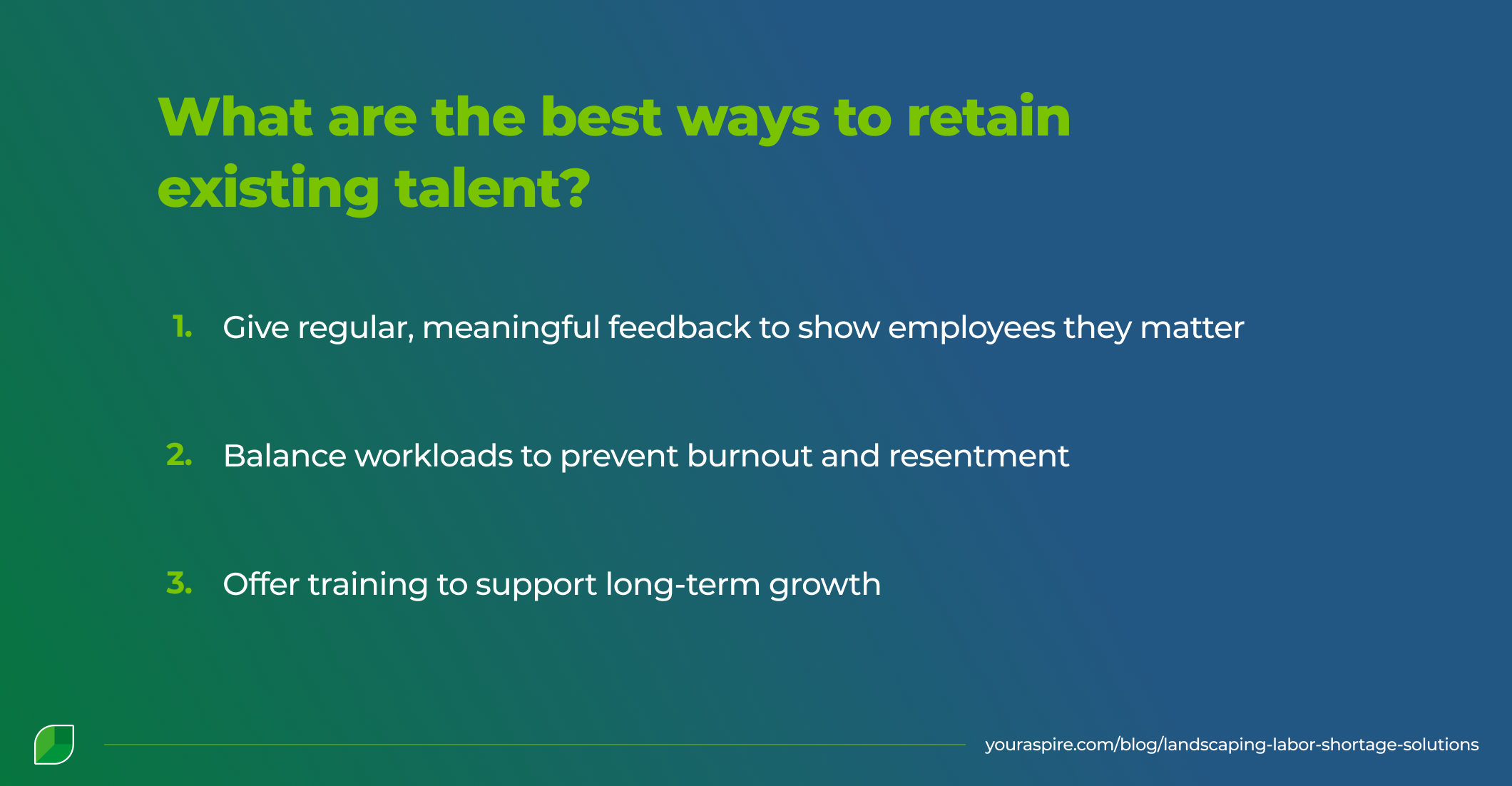
1. Give regular, meaningful feedback to show employees they matter
Aside from regular performance reviews, let your landscaping crew know how they’re doing on a regular basis.
Say you use a tool like Aspire to monitor landscaping operations and find that a crew leader’s team has spent time on a project beyond the estimated hours. Check in with them to find what went wrong. Share constructive feedback on how to move forward.
Simply put, be involved (not in a bossy way) in your crew’s daily performance.
You should check in when an employee performs exceptionally well, too. Focus not just on what could be better but also on what was done well. This helps the team see you as someone concerned about their success in the company.
You could also organize bi-weekly or monthly meetings with the crew where both parties share feedback that can move the operation forward.
2. Balance workloads to prevent burnout and resentment
Assigning the same crew to multiple projects when others have lighter schedules can build frustration among your workforce. Over time, this leads to burnout, resentment, and eventually, high employee turnover.
This kind of imbalance typically happens when you’re managing with spreadsheets or other traditional methods that don’t give you a clear view of the team’s capacity.
You can avoid that by using a smarter scheduling system like Aspire’s to distribute work more fairly and keep crew members from burning out.
Here’s how it works:
Once jobs are won, Aspire automatically populates your schedule based on scope, availability, and crew capacity. This gives you a clear view of your team’s workload—who’s working on what and where.
You can now balance projects across your teams.
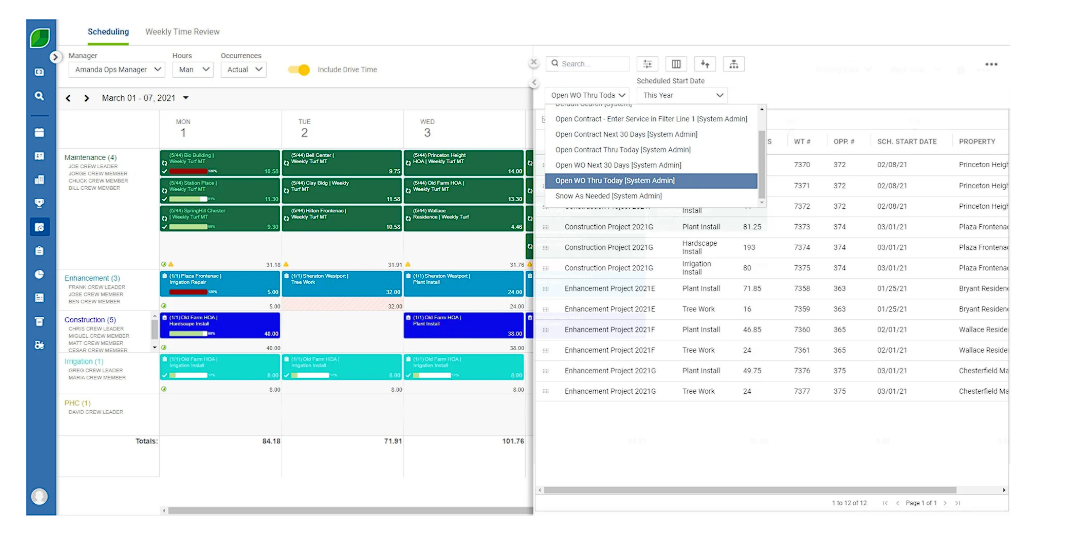
Aspire’s scheduling system makes it difficult to overbook a team while another is underused. And if it happens, you can quickly reassign tasks before burnout sets in.
3. Offer training to support long-term growth
Training ensures your landscaping business consistently delivers high-quality service and remains competitive. But more importantly, it shows employees that you care about their progress, increasing their loyalty.
When you provide upskilling opportunities to prospective candidates, it attracts and motivates them to stay. Plus, it allows them to:
Advance their career.
Learn new skills that will increase their value.
Stay informed about new landscaping trends, equipment, and best practices.
You can take it a step further by paying for certifications and licenses that will see them climb up the career ladder.
How to improve labor efficiency with the team you have
You’re already on the hunt for new employers, but there are still many projects to be completed and few hands to help.
Here’s how you can stay efficient with your existing crew:
Streamline crew scheduling and assignments
Scheduling helps you organize your crews, projects, and equipment efficiently, ensuring jobs are completed on time.
However, things can go sideways when you use systems that don’t give you a clear view of the team’s capacity. This could result in:
Overbooking jobs on busy dates, leading to work overload or client disappointment.
Overstaffing, when you have idle crew members and fewer projects.
Understaffing, more projects, but fewer hands for the job.
To avoid that, you need robust scheduling software like Aspire to help manage assignments and reduce gaps in labor coverage.
With Aspire, you gain insight into won projects and their due dates, so you can plan the team’s schedule effectively. It provides visibility into your crew’s current capacity and availability, helping you set realistic deadlines and avoid overbooking.
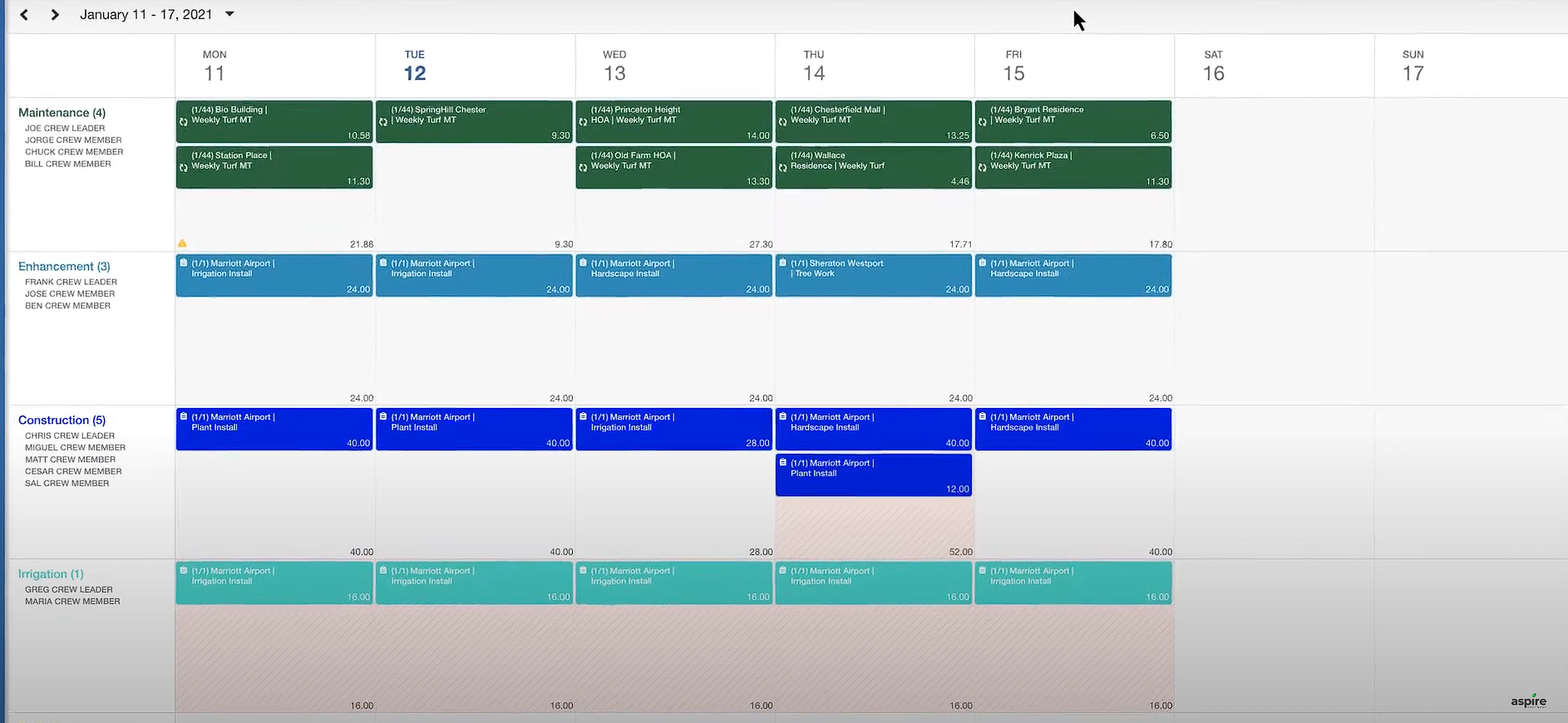
Think of it as a calendar where you can see the team’s itinerary, making it easier to schedule and adjust as needed.
By streamlining scheduling and assignments, you manage the existing landscaping crew and ensure:
Issues like late arrivals and wasted drive time are eliminated, as there’s proper time tracking and route optimization.
Project overlapping or crew running late is avoided; the schedule helps you avoid overbooking.
Crew members are maximized and not overloaded or idle.
Track time, productivity, and job costs accurately
Monitoring how much time your team spends on projects or job sites can help you identify delays, bottlenecks, or idle time. This, in turn, allows you to note crews that need additional training so they can work faster and reallocate time judiciously.
By tracking time, you can eliminate time-wasting habits and help the crew stay focused and efficient on the job.
Measuring productivity is quite similar—you get to recognize top performers or struggling employees. You can now build smarter schedules, enabling you to do more with the same crew.
Job cost tracking, on the other hand, shows you how much time and money are being spent on a project. It spots scope creep and ensures you don’t exceed the job’s margin.
Cost tracking also keeps your crew from being overwhelmed by the client’s demands, so they can take on other projects.
But how do you monitor time, project costs, or productivity?
Enter Aspire. Its field mobile app enables crew members to clock in and out from the job site. This ensures accountability and lets you know how much time is spent on the job.
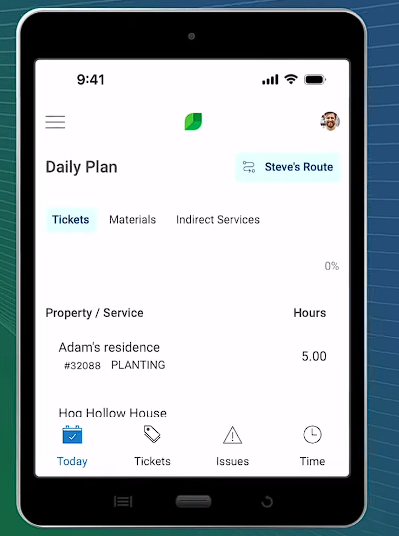
Then, there’s Aspire’s job costing tool that gives you a precise understanding of the actual cost of completing a landscaping project. From materials to equipment and labor, you see whether or not you’re on track with the defined budget.
Invest in equipment that reduces labor dependence
Utilize landscaping machinery and tools that minimize human input, enabling the crew to work faster and with less physical strain.
For instance, instead of assigning three crew members to trim a client’s lawn with push mowers and handheld trimmers, one person with a ride-on mower could complete the job in less time.
The other two can be reassigned to handle edging, prep the next job site, or start another project altogether.
It’s an investment that’s less about replacing people and more about increasing efficiency and multiplying what your team can do in a day.
Now, to ensure the equipment you invest in is used efficiently, leverage Aspire to:
Track the tool’s use in real time: Aspire lets you assign tools to projects and crews, making it easy to track when and how they’re being used.
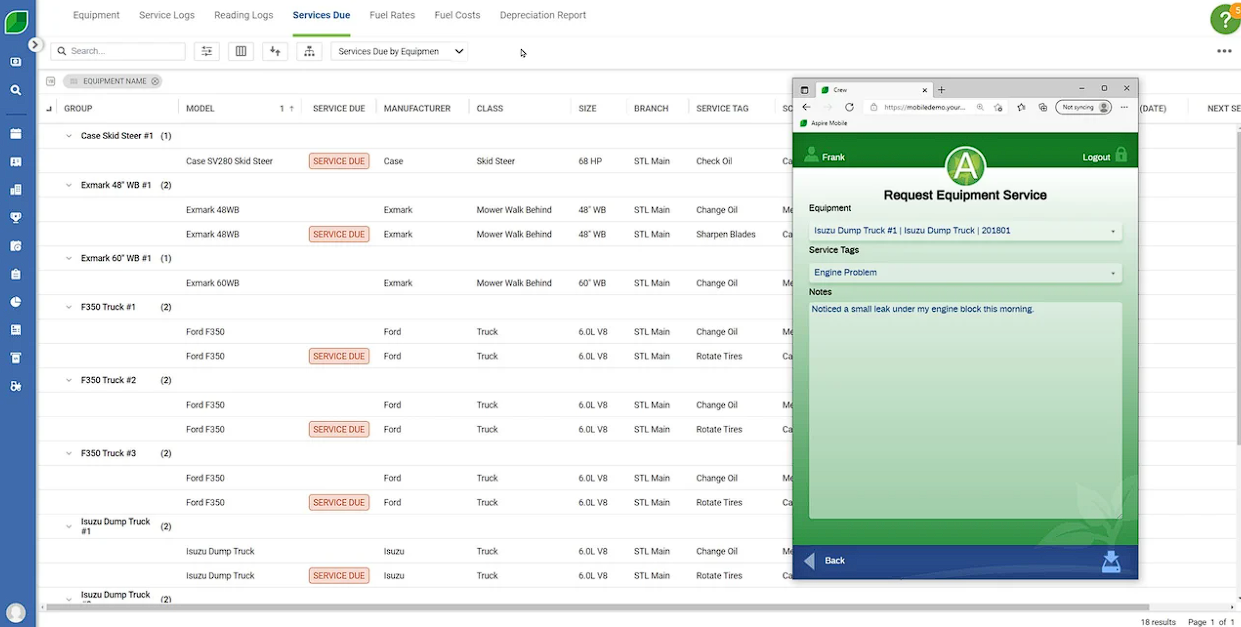
Prevent underuse and boost productivity: Discover which tools are in use or idle and plan your crew’s schedule accordingly. This ensures the team stays productive without delays.
Prevent costly breakdowns: Track equipment maintenance schedules to ensure tools are always in good working order. By monitoring its performance, you know when the gear is due for maintenance. This helps you plan ahead, meaning no downtime due to unexpected breakdowns or repairs.
Can you outsource or subcontract when staffing falls short?
When hiring new employees takes time and your current crew is maxed out, you can do the next best thing: outsource projects to contractors.
Here’s how to approach it strategically:
Recognize when you need external help
Before considering outsourcing, define the circumstances under which it is a good move to avoid unnecessarily increasing job costs.
For instance, outsourcing makes sense when there’s a project with tight deadlines that requires specialized skills your crew doesn’t have. You’ll need external contractors to complete the project and maintain a good brand reputation.
Outsourcing could also be called for when the following arise:
Delayed projects: The job has exceeded its deadline, and there seems to be no feasible end date in view. Contractors can step in to finish the job.
Overworked crews: You have two crews of five landscapers handling 10 projects. They’re working overtime, but it’s still not enough.
Increased customer complaints: Clients aren’t happy with your output because the crew is stretched thin. Do your business a favor and bring in help.
Lost bids due to labor shortages: You’ve missed out on good contracts because you didn’t have enough hands to handle all the different projects.
Vet subcontractors like you would full-time hires
When it’s clear that you need to subcontract work, contact colleagues for recommendations. Then, do your due diligence by vetting their suggestions thoroughly.
Whether it’s a personal recommendation or the contractor reached out through an ad, this step is essential as they’ll be representing your brand.
If they’re professionals and experienced, then there’s no problem, but if they’re bad, they can damage your brand’s reputation.
Here’s how you can vet contractors:
Review their previous projects if possible.
Check and contact their references.
Read client testimonials if they’re online.
Confirm they have the proper licenses and are insured.
Give them test projects and evaluate their expertise with landscaping equipment.
Define clear scopes, expectations, and standards
If they pass the vetting process, your next step is to create contracts that outline expectations, scope of work, payment structure and benefits, and project deadlines.
The contract should be like an employee onboarding document and contract agreement wrapped up in one. The goal is to communicate your brand standards and client expectations.
Lastly, you both need to sign it so the contract is legally binding.
Keep outsourced crews aligned with your schedule
To avoid mix-ups, ensure your internal crew and outsourced team work off the same schedule.
Use centralized scheduling tools like Aspire to assign tasks to both teams, set timelines, and track progress in real time. This ensures everyone knows where to be and when, reducing delays or confusion on the job site.
Track performance and make data-driven outsourcing decisions
Once hired, monitor subcontractors' performance across job quality, client feedback, and timeliness. This will help you better understand the kind of subsequent projects to use them for, or if they’re even the right fit for your company.
Leverage Aspire’s reporting feature to pull data from your different landscaping operations and performance. It allows you to track a crew’s productivity and the project cost, so you can decide if their contract should be renewed.
Over to you!
The factors affecting the current landscaping labor shortage may not change anytime soon, but smart businesses are adapting.
Whether it’s implementing new recruitment approaches, boosting retention, or maximizing your internal crew, the right approach outlined above keeps you ahead of the competition.
Take it further by amplifying your efforts with Aspire. This landscaping business tool enables you to manage and streamline your operations efficiently. You’ll not only experience a smoother workflow but also a boost in the team’s output, increasing productivity.
Want to see it in action?


